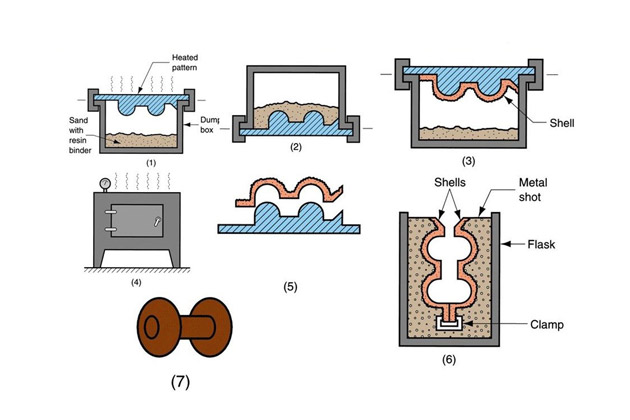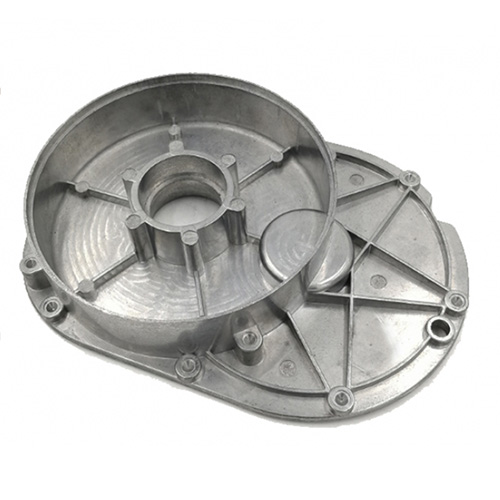The strengths of corrosion resistance in Aluminum Casting
Comprehending the Benefits and Varieties of Aluminum Castings in Industry
Aluminum castings have actually ended up being increasingly essential across different markets due to their unique properties and making adaptability. Their light-weight and corrosion-resistant nature makes them suitable for requiring applications. Different spreading techniques permit precise and intricate designs. As markets advance, comprehending the range of light weight aluminum spreading options and their benefits is vital. This exploration raises questions concerning their future role in manufacturing and sustainability. What lies ahead for aluminum in these sectors?
The Fundamentals of Aluminum Casting Processes
Aluminum spreading processes vary in strategy, they all share a typical objective: to change liquified light weight aluminum right into precise forms and elements. The main methods of light weight aluminum casting consist of sand casting, die casting, and investment casting. In sand casting, molds are developed utilizing sand, permitting elaborate layouts yet usually resulting in a rough surface area coating. Die casting utilizes high-pressure shot of liquified light weight aluminum right into steel mold and mildews, yielding high precision and smooth surfaces, ideal for automation. Financial investment casting, or lost-wax spreading, includes developing a wax pattern coated with a ceramic shell, providing extraordinary detail and dimensional precision. Each approach has its specific applications and considerations, including expense, manufacturing quantity, and complexity of the forms created. Comprehending these fundamental methods is important for sectors that depend on light weight aluminum castings to meet their design and useful demands.
Trick Benefits of Utilizing Aluminum Castings
Aluminum castings supply various benefits that make them a preferred option in numerous sectors. One of the essential advantages is their lightweight nature, which enables much easier handling and lowered delivery expenses. This characteristic adds to enhanced energy performance, especially in auto and aerospace applications. In addition, light weight aluminum exhibits excellent deterioration resistance, prolonging the life expectancy of components and decreasing upkeep demands.
An additional benefit is the convenience of aluminum castings, which can be built right into complex shapes, enabling cutting-edge layouts that traditional products might not fit. The thermal and electric conductivity of light weight aluminum likewise makes it excellent for applications requiring heat dissipation or effective electric connections. Aluminum castings are recyclable, aligning with sustainability goals and reducing ecological impact. On the whole, the mix of strength, durability, and flexibility makes light weight aluminum castings an important component in modern-day manufacturing practices throughout several industries.
Typical Kinds Of Aluminum Castings
Aluminum castings are produced with different methods, each fit for various applications and demands. Among the most typical methods are sand casting, which offers versatility and cost-effectiveness, and pass away casting, understood for its accuracy and efficiency. Understanding these procedures is vital for picking the suitable spreading technique for certain commercial demands.
Sand Casting Refine
A considerable portion of light weight aluminum castings in industry is produced via the sand spreading process, which is renowned for its convenience and cost-effectiveness. This approach includes developing a mold and mildew from a sand mixture, permitting the production of complicated shapes and large elements. Sand spreading is specifically advantageous for tiny to medium-sized production runs, as it needs very little preliminary financial investment in tooling. The process begins with pattern production, adhered to by mold preparation, putting liquified light weight aluminum, and ultimately, cooling and ending up. The high thermal conductivity of light weight aluminum guarantees even cooling, reducing the danger of flaws. Consequently, sand spreading stays a favored selection for makers seeking efficiency and versatility in their light weight aluminum casting applications.
Die Casting Techniques
Die casting techniques stand for a highly effective approach for creating aluminum castings, particularly suited for high-volume production. These methods mainly include two common types: warm chamber and cool chamber pass away casting. In warm chamber pass away spreading, the molten light weight aluminum is infused into the mold from a tank that is heated, making it perfect for low-melting-point alloys. On the other hand, cool chamber pass away casting entails pouring the molten light weight aluminum into a different chamber prior to injection, which accommodates greater melting-point materials. Both approaches offer precision in shaping intricate geometries and accomplishing exceptional surface area coatings. In addition, pass away casting is understood for its quick cycle times, decreasing production expenses while maintaining consistency in high quality across large amounts of components.
Applications in the Automotive Market
Transforming car layout and efficiency, light weight aluminum castings play a necessary duty in the automotive sector. These castings add substantially to weight decrease, enhancing gas performance and overall automobile dynamics. Key applications include engine blocks, transmission housings, and suspension elements, where their light-weight nature and strength are crucial.
Aluminum castings likewise allow for complicated geometries, enabling makers to produce elaborate layouts that optimize air flow and reduce drag. This capacity is specifically valuable in electric and hybrid cars, where performance and performance are extremely important.
In addition, the deterioration resistance of light weight aluminum expands the life-span of auto parts, reducing upkeep costs and improving lorry reliability. The adaptability of aluminum castings sustains both mass production and personalized applications, making them a favored selection among auto designers and designers. Aluminum Casting. As the market remains to introduce, light weight aluminum castings will stay an important component in the pursuit of innovative automotive innovations
Aerospace Industry Application
In the aerospace sector, light weight aluminum castings are indispensable to the style and performance of aircraft elements. These castings are utilized in various applications, consisting of engine components, structural elements, and interior installations. Their lightweight nature adds to boosted fuel efficiency and general efficiency, which is important in aerospace engineering.
Aluminum castings also use excellent strength-to-weight proportions, permitting producers to develop complex layouts without jeopardizing architectural integrity. The capability to produce complex geometries makes aluminum casting a favored choice for components that need accuracy and dependability.
Additionally, light weight aluminum's resistance to deterioration boosts the durability of aerospace components, decreasing maintenance expenses and improving safety (Aluminum Casting). The spreading procedure permits high-volume production, fulfilling the market's demands for efficiency. In general, aluminum castings play a crucial function ahead of time aerospace modern technology and optimizing airplane design, contributing to the industry's ongoing innovations

Advantages Over Various Other Products
Aluminum castings use substantial benefits over various other materials, making them a recommended selection in various industries. Among the primary benefits is their lightweight nature, which contributes to decreased energy consumption and enhanced performance in applications such as auto and aerospace. In addition, aluminum displays exceptional corrosion resistance, allowing for extended sturdiness and go to this site reduced upkeep prices.
The material's superior thermal and electric conductivity further enhances its charm, especially in applications needing heat dissipation or effective power transfer. Aluminum Casting. Aluminum castings also provide excellent dimensional security, ensuring accurate tolerances and lowering the possibility of defects during the manufacturing process
Moreover, the versatility of aluminum enables complex shapes and complex layouts, which can be accomplished with numerous casting methods. This versatility makes aluminum an important alternative for suppliers intending to innovate while preserving cost-effectiveness and quality. In conclusion, aluminum castings stick out as a result of their unique mix of homes that satisfy varied commercial demands.
Future Trends in Aluminum Casting Innovation
Future patterns in light weight aluminum casting technology are increasingly concentrated on automation and the development of sophisticated alloys. Automation stands to boost effectiveness and accuracy in casting procedures, minimizing labor costs and enhancing product consistency. Concurrently, innovations in alloy solutions promise to expand the series of applications for aluminum castings, dealing with details efficiency needs in various sectors.
Automation in Casting Processes

Advanced Alloys Growth
With the continuous advancement of product scientific research, the development of sophisticated alloys is readied to change light weight aluminum casting innovation significantly. These ingenious alloys are developed to enhance mechanical buildings, deterioration resistance, and thermal stability, dealing with diverse commercial applications. Scientists are concentrating on hybrid alloys that include elements such as magnesium, silicon, and zinc to achieve peak performance. Furthermore, innovations in computational modeling and simulation are enabling the prediction of alloy habits under different conditions, enhancing the style process. The combination of reusing technologies is likewise becoming vital, enabling makers to generate high-performance aluminum castings while decreasing ecological effect. As these fads proceed, the light weight aluminum casting sector is most likely to witness substantial renovations in performance, sustainability, and product top quality.
Regularly Asked Questions
Exactly How Is Aluminum Casting Eco-friendly?
The concern of aluminum spreading's environmental kindness develops from its recyclability and lower energy consumption compared to other metals. Furthermore, developments in lasting practices further boost its environmentally friendly credibility within producing procedures.
What Is the Normal Life-span of Aluminum Castings?
The typical life-span of aluminum castings varies based upon application and atmosphere, normally ranging from a number navigate to this site of years to decades. Variables such as direct exposure to harsh elements and mechanical stress and anxiety can greatly influence their resilience and long life.
Can Aluminum Castings Be Reused?
Aluminum castings can undoubtedly be reused. This procedure substantially lowers waste and saves sources, enabling makers to reuse materials successfully. Reusing aluminum castings adds to sustainability and decreases the environmental influence connected with aluminum manufacturing.
What Are the Typical Defects in Aluminum Castings?
Common flaws in light weight aluminum castings consist of porosity, contraction, imbalance, and surface area imperfections. These issues can occur from inadequate putting methods, inappropriate alloy composition, or not enough cooling, ultimately affecting the quality and performance of the end product.
How Do I Choose the Right Aluminum Casting Refine?
Choosing the right aluminum spreading process calls for assessing production volume, part intricacy, and wanted properties. Factors such as cost, preparation, and material features additionally influence the choice, making sure perfect outcomes for particular applications.